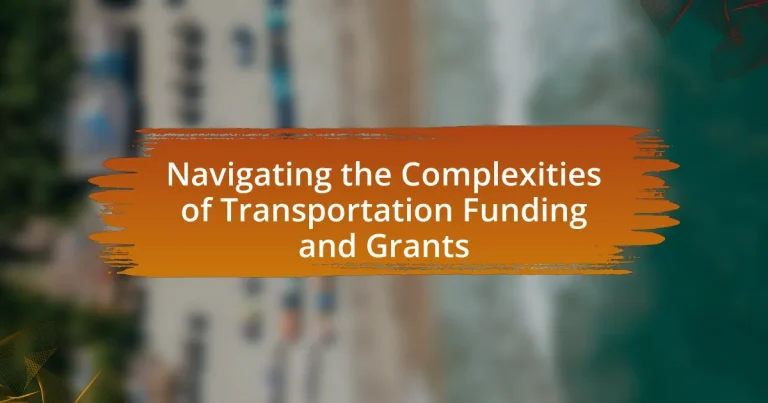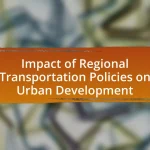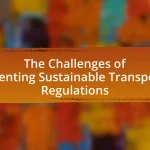The article focuses on the complexities of transportation funding and grants, detailing the various funding sources, regulatory requirements, and eligibility criteria that influence project success. It examines the roles of federal, state, and local funding, highlighting how these sources impact project scope and feasibility. Additionally, the article addresses common challenges in the grant application process, strategies for navigating requirements, and the importance of stakeholder collaboration. Key components of funding mechanisms, eligibility criteria, and best practices for securing grants are also discussed, providing a comprehensive overview of the transportation funding landscape.

What are the complexities of transportation funding and grants?
Transportation funding and grants involve multiple complexities, including diverse funding sources, regulatory requirements, and varying eligibility criteria. Different levels of government—federal, state, and local—provide funding through programs like the Federal Highway Administration and the Federal Transit Administration, each with specific guidelines and restrictions. Additionally, the competition for limited resources can complicate the grant application process, as agencies must navigate intricate scoring systems and prioritize projects based on factors such as economic impact, environmental sustainability, and community needs. Furthermore, the need for matching funds often poses a challenge for local governments, which may struggle to secure the necessary financial contributions. These complexities can lead to delays in project implementation and require extensive planning and coordination among stakeholders.
How do different funding sources impact transportation projects?
Different funding sources significantly impact transportation projects by influencing project scope, timelines, and overall feasibility. Federal funding often comes with strict guidelines and requirements, which can dictate project design and implementation processes. For instance, projects funded through the Federal Highway Administration must comply with specific environmental regulations, potentially extending timelines. State and local funding sources may offer more flexibility but can be limited in scale, affecting the project’s overall budget and reach. Additionally, private funding can introduce innovative solutions but may prioritize profit-driven outcomes over public needs. According to the American Society of Civil Engineers, transportation projects funded through diverse sources can experience variations in completion rates and cost overruns, highlighting the critical role funding sources play in shaping project success.
What are the primary types of transportation funding sources?
The primary types of transportation funding sources include federal funding, state funding, local funding, and private funding. Federal funding often comes from programs like the Federal-Aid Highway Program, which allocates billions annually for highway construction and maintenance. State funding typically involves state transportation budgets that support infrastructure projects, while local funding is derived from municipal budgets and local taxes. Private funding can include investments from businesses and public-private partnerships aimed at enhancing transportation infrastructure. These funding sources collectively support the development and maintenance of transportation systems across various levels of government and sectors.
How do federal, state, and local funding differ in their application?
Federal, state, and local funding differ in their application primarily in terms of source, purpose, and allocation processes. Federal funding typically comes from national tax revenues and is often designated for large-scale projects that have nationwide significance, such as interstate highways, with specific guidelines set by federal agencies like the Federal Highway Administration. State funding is sourced from state taxes and is generally aimed at regional projects, allowing for more flexibility in addressing local needs while adhering to state regulations. Local funding, derived from municipal budgets and local taxes, focuses on community-specific projects, such as local road maintenance and public transit improvements, with decisions made by local government entities. This tiered structure ensures that funding aligns with the scale and impact of transportation projects, facilitating targeted investment at each governmental level.
Why is understanding transportation grants essential for project success?
Understanding transportation grants is essential for project success because they provide critical funding that can significantly impact the feasibility and scope of transportation initiatives. These grants often cover a substantial portion of project costs, enabling planners and stakeholders to allocate resources effectively and pursue ambitious goals. For instance, the Federal Transit Administration awarded over $2 billion in grants in 2021, demonstrating the scale of financial support available for transportation projects. By comprehensively understanding the eligibility criteria, application processes, and reporting requirements associated with these grants, project leaders can enhance their chances of securing funding and ensure compliance, ultimately leading to successful project implementation.
What are the common challenges faced when applying for transportation grants?
Common challenges faced when applying for transportation grants include complex application processes, stringent eligibility requirements, and competition for limited funding. The application processes often involve detailed documentation and compliance with federal, state, or local regulations, which can be overwhelming for applicants. Additionally, many grants have specific eligibility criteria that can exclude potential applicants, making it difficult for some organizations to qualify. Furthermore, the high level of competition for available funds means that even well-prepared applications may not secure funding, as many projects vie for the same resources. These factors contribute to the overall difficulty in successfully obtaining transportation grants.
How can project managers effectively navigate grant requirements?
Project managers can effectively navigate grant requirements by thoroughly understanding the specific guidelines and criteria set forth by the funding agency. This involves carefully reviewing the grant application instructions, eligibility requirements, and reporting obligations to ensure compliance. For instance, the National Institutes of Health (NIH) provides detailed grant application guidelines that outline necessary documentation and deadlines, which project managers must follow to avoid disqualification. Additionally, maintaining clear communication with grant officers can provide clarification on ambiguous requirements and facilitate a smoother application process. By implementing these strategies, project managers can enhance their ability to meet grant requirements successfully.

What are the key components of transportation funding mechanisms?
The key components of transportation funding mechanisms include federal funding, state funding, local funding, user fees, and public-private partnerships. Federal funding, primarily through programs like the Highway Trust Fund, provides significant financial resources for transportation projects, accounting for approximately 25% of total funding in the U.S. State funding typically comes from gas taxes and vehicle registration fees, which contribute to about 30% of transportation budgets. Local funding sources, such as property taxes and sales taxes, also play a crucial role, making up around 20% of funding. User fees, including tolls and transit fares, generate additional revenue, while public-private partnerships leverage private investment for infrastructure development, enhancing overall funding capacity. These components collectively ensure a diversified and sustainable approach to financing transportation systems.
How do eligibility criteria affect access to transportation funding?
Eligibility criteria significantly influence access to transportation funding by determining which entities can apply for and receive financial support. These criteria often include factors such as project type, geographic location, and the applicant’s financial capacity, which can restrict funding opportunities to specific groups, such as local governments or non-profit organizations. For instance, the Federal Transit Administration’s funding programs typically require applicants to demonstrate compliance with federal regulations and local planning processes, thereby limiting access to those who meet these stringent requirements. Consequently, entities that do not fulfill these eligibility criteria may find themselves excluded from vital funding sources, impacting their ability to develop or enhance transportation infrastructure.
What factors determine eligibility for federal transportation grants?
Eligibility for federal transportation grants is determined by several key factors, including the type of project, compliance with federal regulations, and the applicant’s ability to demonstrate financial need. Projects must align with federal transportation goals, such as improving safety, enhancing mobility, or reducing environmental impact. Additionally, applicants must adhere to specific federal guidelines, such as those outlined in the Fixing America’s Surface Transportation (FAST) Act, which mandates that projects meet certain criteria to qualify for funding. Financial need is assessed through the applicant’s budget and funding sources, ensuring that federal funds are allocated to projects that require assistance.
How do local regulations influence funding opportunities?
Local regulations significantly influence funding opportunities by establishing eligibility criteria and compliance requirements for projects. These regulations dictate how funds can be allocated, often prioritizing projects that align with local development goals, environmental standards, and community needs. For instance, municipalities may require adherence to specific zoning laws or environmental assessments, which can either facilitate or hinder access to state and federal funding. Additionally, local regulations can shape the competitive landscape for grants, as projects that meet regulatory standards are more likely to receive financial support. This relationship underscores the importance of understanding local regulatory frameworks when seeking funding for transportation initiatives.
What role do stakeholders play in transportation funding decisions?
Stakeholders play a crucial role in transportation funding decisions by influencing priorities, shaping policies, and determining the allocation of resources. These stakeholders include government agencies, local communities, private sector entities, and advocacy groups, each contributing unique perspectives and needs that impact funding outcomes. For instance, government agencies often set funding criteria and priorities based on public needs and safety considerations, while local communities advocate for projects that address their specific transportation challenges. Research indicates that stakeholder engagement can lead to more effective and equitable funding decisions, as seen in the Federal Highway Administration’s guidelines, which emphasize the importance of public involvement in the planning process.
Who are the primary stakeholders involved in transportation funding?
The primary stakeholders involved in transportation funding include federal, state, and local government agencies, private sector companies, non-profit organizations, and community groups. Federal agencies, such as the U.S. Department of Transportation, allocate significant funding through programs like the Federal-Aid Highway Program, which provides billions annually for infrastructure projects. State and local governments contribute additional funding and are responsible for project implementation. Private sector companies often engage in public-private partnerships to finance and develop transportation projects, while non-profit organizations and community groups advocate for equitable funding and represent public interests. This multi-faceted involvement ensures a comprehensive approach to transportation funding, addressing diverse needs and priorities.
How can collaboration among stakeholders enhance funding success?
Collaboration among stakeholders enhances funding success by pooling resources, expertise, and networks, which increases the likelihood of securing financial support. When stakeholders, such as government agencies, private sector partners, and community organizations, work together, they can present a unified proposal that demonstrates broad support and shared objectives. This collective approach often leads to more comprehensive project plans that address diverse community needs, making them more attractive to funders. For instance, studies show that collaborative projects in transportation funding have a higher success rate, as they can leverage multiple funding sources and align with regional development goals, thereby increasing their viability and sustainability.

What strategies can be employed to secure transportation funding and grants?
To secure transportation funding and grants, organizations should develop comprehensive project proposals that clearly outline objectives, benefits, and budget requirements. Effective strategies include engaging stakeholders to demonstrate community support, aligning projects with federal and state funding priorities, and leveraging data to showcase the project’s potential impact. For instance, the Federal Highway Administration emphasizes the importance of data-driven decision-making in securing funding, as projects backed by solid evidence are more likely to receive financial support. Additionally, establishing partnerships with local governments and private entities can enhance credibility and resource sharing, further increasing the likelihood of obtaining grants.
How can project proposals be tailored to meet funding criteria?
Project proposals can be tailored to meet funding criteria by aligning the project’s objectives, budget, and outcomes with the specific requirements outlined by the funding agency. This involves thoroughly reviewing the funding guidelines to identify key priorities, such as sustainability, community impact, or innovation, and ensuring that the proposal explicitly addresses these elements. For instance, if a funding source prioritizes environmental sustainability, the proposal should include detailed plans for reducing carbon emissions or enhancing green infrastructure. Additionally, incorporating measurable outcomes and a clear evaluation plan can demonstrate the project’s potential effectiveness, which is often a critical factor for funders. By directly linking the proposal’s components to the funder’s goals, the likelihood of securing funding increases significantly.
What elements should be included in a compelling funding proposal?
A compelling funding proposal should include a clear project description, a defined budget, measurable objectives, a timeline, and an evaluation plan. The project description outlines the purpose and significance of the initiative, while the budget details the financial requirements and justifications for each expense. Measurable objectives provide specific targets to assess success, and the timeline establishes key milestones for project implementation. Lastly, the evaluation plan describes how outcomes will be measured and reported, ensuring accountability and transparency. These elements are essential for demonstrating the project’s viability and alignment with funding priorities, which increases the likelihood of securing financial support.
How can data and research support funding applications?
Data and research can significantly enhance funding applications by providing evidence-based justification for project needs and potential impacts. For instance, statistical analyses can demonstrate the demand for transportation improvements, such as increased traffic congestion data or safety statistics, which can persuade funding bodies of the project’s urgency. Additionally, research findings can outline best practices and successful case studies from similar projects, showcasing the feasibility and expected outcomes, thereby increasing the credibility of the application. According to a study by the Transportation Research Board, projects supported by robust data and research are 30% more likely to receive funding compared to those lacking such evidence.
What best practices can improve the chances of obtaining transportation grants?
To improve the chances of obtaining transportation grants, applicants should focus on developing a clear, detailed project proposal that aligns with the funding agency’s goals. A well-structured proposal includes specific objectives, a comprehensive budget, and a timeline, demonstrating the project’s feasibility and impact. Research shows that proposals that directly address the priorities outlined in grant announcements have a higher success rate; for instance, the Federal Highway Administration emphasizes alignment with national transportation goals in their funding criteria. Additionally, engaging stakeholders and demonstrating community support can strengthen the application, as evidenced by studies indicating that projects with broad backing are more likely to receive funding.
How can networking and partnerships enhance grant opportunities?
Networking and partnerships can significantly enhance grant opportunities by expanding access to resources, expertise, and collaborative projects. When organizations engage in networking, they can share knowledge about funding sources, application processes, and best practices, which increases the likelihood of successful grant applications. For instance, partnerships can lead to joint proposals that demonstrate a broader impact and community support, making applications more attractive to funders. Research indicates that collaborative projects often receive higher funding amounts, as they showcase a united effort towards common goals, which is particularly relevant in the transportation sector where multi-stakeholder involvement is crucial for addressing complex challenges.
What are the common pitfalls to avoid in the grant application process?
Common pitfalls to avoid in the grant application process include failing to follow guidelines, underestimating the time required for preparation, and neglecting to clearly articulate project goals. Adhering to specific guidelines is crucial, as many applications are rejected for not meeting basic requirements. Research indicates that applicants often underestimate the time needed to gather necessary documentation and develop a compelling narrative, leading to rushed submissions that lack detail. Additionally, a clear articulation of project goals is essential; studies show that proposals lacking clarity in objectives are less likely to receive funding.
What practical tips can help organizations navigate transportation funding effectively?
Organizations can navigate transportation funding effectively by establishing strong relationships with funding agencies, thoroughly understanding eligibility requirements, and preparing detailed project proposals. Building relationships with agencies such as the Federal Highway Administration or local transportation authorities can provide insights into funding opportunities and priorities. Understanding eligibility requirements ensures that organizations apply for the right funding sources, which can vary significantly; for instance, the Federal Transit Administration has specific criteria for public transit projects. Preparing detailed project proposals that clearly outline objectives, budget, and expected outcomes increases the likelihood of securing funding, as evidenced by studies showing that well-structured proposals are more likely to be funded.


